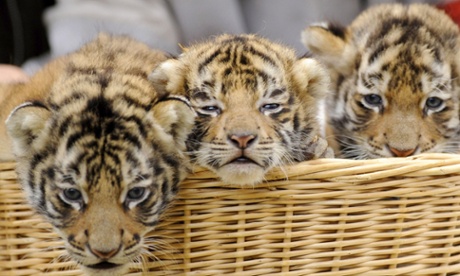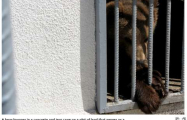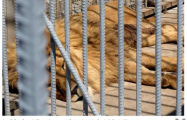The neighbours of Mher Sedrakian, an MP in Armenia’s ruling Republican party, have a persistent problem with noise. But this is not about wild parties or car horns. Rather, it is about lions.
The lions that Sedrakian allegedly keeps as pets at his home in the Armenian capital Yerevan roar continuously, his neighbours complain.
Increasingly, many Armenians can understand that concern. Private zoos with lions, tigers and bears are emerging as a popular hobby for the wealthy and powerful, and the government does not seem inclined to intervene.
Instead, recent amendments to wildlife legislation seem to facilitate this pastime. Private citizens are allowed to own wild animals, including endangered species, as long as they provide areas for the animals that ensure their “life, health and safety”, and prevent escape from captivity, the law says. Supervision is supposed to be “constant”.
But it is not. Last November, tiger cubs were found in the streets of Etchmiadzin, a town about 12 miles from the capital, Yerevan, local media reported.
Although tigers, as an endangered species, cannot be exported from the wild, their import from zoos is allowed.
A search of the Convention on International Trade in Endangered Species of Wild Fauna and Flora (Cites) database for 2008 to 2013 shows the import of six tigers to Armenia, including three Siberian tigers from Ukraine. The others came from Belgium, Chile and Kazakhstan.
An Armenian border guard official, who declined to be named, said that a tiger can be brought into the country if documents show its country of origin and demonstrate that it is the third generation of a zoo-based line.
A Cites certificate that authorises the animal’s shipment is also required, said Hovhannes Mkrtchian, head of the ministry of agriculture’s food security department, which checks import documents and verifies the animals’ health.
Yet investigative reports by the news site Hetq.am indicate that not all of the exotic animals imported into Armenia – for example an endangered bonobo – end up in the Cites database.
Similarly, though crocodiles were offered for sale in Yerevan supermarkets last December for New Year’s celebrations, the database contains no mention of their import as food products.
It does, however, show an array of exotic imports. Cheetahs topped the feline list, with 18 imports from the United Arab Emirates and South Africa between 2008 and 2013. Nine lions were brought in during the same period; most from the United Arab Emirates.
Forty-one dumbo-eared fennec foxes, natives of the Sahara, entered Armenia between 2009 and 2010, while 21 rheas, ostrich-like birds from South America, made the trip in 2012.
Whether or not these animals were meant for the Yerevan zoo was not immediately clear.
Yerevan zoo director Ruben Khachatrian said his facility was “making every effort to meet international standards”, and expressed regret that Armenia had developed a reputation for an illegal trade in wild animals.
“Because of certain persons, Armenia has a bad international image in terms of the unlawful trade in animals,” Khachatrian said. “[Individuals] can approach you at international conferences and ask with anxiety, ‘What is going on in your country?’”
The government launched a criminal investigation into the importation of animals after the Hetq.am investigation, but no results have been announced.
Among those known to have a taste for exotic wildlife is one of Armenia’s most powerful political players, millionaire businessman Gagik Tsarukian, the head of the opposition Prosperous Armenia Party.
A 2009 YouTube video showing a donkey placed in a cage of lions was widely reputed to have been filmed at Tsarukian’s Yerevan residence, which contains a private zoo.
His spokesperson, Iveta Tonoian, denied any connection to the case, but has said that Tsarukian owns about two dozen lions and white tigers, which live “in perfect conditions”.
Tsarukian is not alone in his tastes. Former deputy defence minister Lieutenant General Manvel Grigorian, the head of an influential organisation of Karabakh war veterans, keeps tigers, lions, bears and various birds in a private zoo in the town of Etchmiadzin.
According to Hetq.am, an allegedly toothless tiger also protects Grigorian’s Etchmiadzin house. The tiger cub found wandering in the town last year is believed to have belonged to the general, who has not responded to the allegations.
But holding any political figure to account on such a score is difficult.
Environmentalists say the government has not responded to their requests to see the documentation for the endangered brown bears allegedly owned by Hovik Abovian, the governor of the northern province Tavush.
The agriculture ministry’s Mkrtchian, however, says that “everything is done in accordance with procedures”.
“We do everything we can to ensure safety,” he said.
But it does not always work. In 2012 a lion allegedly owned by a former police colonel seriously injured a two-year-old child in a village not far from the Turkish border.
Environmentalist Silva Adamian argues that the law on wildlife simply does not work. “Legislators should have the leverage to control the field, whereas the opposite is happening,” said Adamian.
Restaurants throughout the country offer the meat of bears, boars and deer, all endangered in Armenia, on their menus. Bears can also be seen on the loose in Yerevan itself – there were two reported spottings twice within the last year.
Adamian said civil society groups were not prepared to take up the issue either. “The field is controlled by certain influential people, while society is so busy with other problems that it simply has no time to take an interest in these issues,” she said.
The government declined to comment on the allegations.


















































